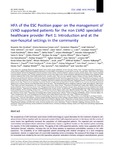HFA of the ESC position paper on the management of LVAD supported patients for the non LVAD specialist healthcare provider part 1: introduction and at the non-hospital settings in the community

View/
Use this link to cite
http://hdl.handle.net/2183/30173
Except where otherwise noted, this item's license is described as Creative Commons Attribution-NonCommercial-NoDerivatives 4.0 International License (CC-BY-NC-ND 4.0)
Collections
- Investigación (FCS) [1293]
Metadata
Show full item recordTitle
HFA of the ESC position paper on the management of LVAD supported patients for the non LVAD specialist healthcare provider part 1: introduction and at the non-hospital settings in the communityAuthor(s)
Date
2021-09-14Citation
Ben Avraham B, Crespo-Leiro MG, Filippatos G, Gotsman I, Seferovic P, Hasin T, Potena L, Milicic D, Coats AJS, Rosano G, Ruschitzka F, Metra M, Anker S, Altenberger J, Adamopoulos S, Barac YD, Chioncel O, De Jonge N, Elliston J, Frigeiro M, Goncalvesova E, Grupper A, Hamdan R, Hammer Y, Hill L, Itzhaki Ben Zadok O, Abuhazira M, Lavee J, Mullens W, Nalbantgil S, Piepoli MF, Ponikowski P, Ristic A, Ruhparwar A, Shaul A, Tops LF, Tsui S, Winnik S, Jaarsma T, Gustafsson F, Ben Gal T. HFA of the ESC Position paper on the management of LVAD supported patients for the non LVAD specialist healthcare provider Part 1: Introduction and at the non-hospital settings in the community. ESC Heart Fail. 2021 Dec;8(6):4394-4408.
Abstract
[Abstract] The accepted use of left ventricular assist device (LVAD) technology as a good alternative for the treatment of patients with advanced heart failure together with the improved survival of the LVAD-supported patients on the device and the scarcity of donor hearts has significantly increased the population of LVAD-supported patients. The expected and non-expected device-related and patient-device interaction complications impose a significant burden on the medical system exceeding the capacity of the LVAD implanting centres. The ageing of the LVAD-supported patients, mainly those supported with the 'destination therapy' indication, increases the risk for those patients to experience comorbidities common in the older population. The probability of an LVAD-supported patient presenting with medical emergency to a local emergency department, internal, or surgical ward of a non-LVAD implanting centre is increasing. The purpose of this trilogy is to supply the immediate tools needed by the non-LVAD specialized physician: ambulance clinicians, emergency ward physicians, general cardiologists, internists, anaesthesiologists, and surgeons, to comply with the medical needs of this fast-growing population of LVAD-supported patients. The different issues discussed will follow the patient's pathway from the ambulance to the emergency department and from the emergency department to the internal or surgical wards and eventually to the discharge home from the hospital back to the general practitioner. In this first part of the trilogy on the management of LVAD-supported patients for the non-LVAD specialist healthcare provider, after the introduction on the assist devices technology in general, definitions and structured approach to the assessment of the LVAD-supported patient in the ambulance and emergency department is presented including cardiopulmonary resuscitation for LVAD-supported patients.
Keywords
LVAD
General description
Emergency medical systems
CPR
General description
Emergency medical systems
CPR
Editor version
Rights
Creative Commons Attribution-NonCommercial-NoDerivatives 4.0 International License (CC-BY-NC-ND 4.0)
ISSN
2055-5822






